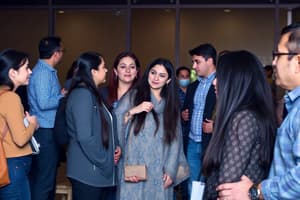Podcast
Questions and Answers
What term refers to a group of individuals who have strong emotional ties and interact frequently?
What term refers to a group of individuals who have strong emotional ties and interact frequently?
- Network organizations
- Formal organizations
- Secondary groups
- Primary groups (correct)
Which type of group is primarily focused on achieving specific goals and operates in a structured manner?
Which type of group is primarily focused on achieving specific goals and operates in a structured manner?
- Secondary groups
- Network organizations
- Formal organizations (correct)
- Primary groups
What phrase encapsulates the idea that society exists only through individual actions and relationships?
What phrase encapsulates the idea that society exists only through individual actions and relationships?
- Society is made up of individual men and women (correct)
- Society functions without individual contributions
- Society is composed of families
- Society is a collective entity
Which group type includes associations that are less personal and may focus on shared interests?
Which group type includes associations that are less personal and may focus on shared interests?
What type of organization emphasizes relationships and activities but lacks a formal structure?
What type of organization emphasizes relationships and activities but lacks a formal structure?
Flashcards
Primary Groups
Primary Groups
Groups formed based on personal relationships, such as families or close friends.
Secondary Groups
Secondary Groups
Larger, more impersonal groups, such as schools or workplaces.
Formal Organizations
Formal Organizations
Organizations with a structured hierarchy and clear goals, such as businesses or government agencies.
Network Organizations
Network Organizations
Signup and view all the flashcards
Government Action through Individuals
Government Action through Individuals
Signup and view all the flashcards
Study Notes
Key Concepts in the Social Sciences - Lecture 3
- Today's key concepts: Groups and organizations, Social interactions
- Groups and organizations: Social groups, conformity, Organizations and bureaucracy, Networks
- Social interactions: Structure and agency, Development and construction of the self, Roles and performances, Studying social interactions
- Changing social interactions (Amsterdam, 1999): Visual depiction of social interactions
- Recap: Societies are defined as groups interacting in a specific space and sharing culture. Societies are constantly changing, evolving from hunter-gatherer societies to modern network societies. Societal shifts affect how and with whom individuals interact.
- Social groups: Social groups are comprised of two or more people who interact and identify with each other.
- Primary social groups: Small groups with enduring personal relationships.
- Secondary social groups: Large, impersonal groups who share a common interest or activity.
- Reference groups: A social group providing a benchmark for comparisons and decision making.
- Secondary social groups examples: Illustrations highlighting specific interest groups.
- Why are social groups so important?: Group behavior is heavily influenced by group size (like dyads or triads). Larger groups may be divided into subgroups to facilitate communication and collaboration. The ideal size depends on the purpose and structure of the group. Georg Simmel contributed to the study of group properties.
- Group conformity (exactitudes): Images displaying similar group dress in both conformity and non-conformity examples.
- Other (less frivolous) examples: Milgram Shock Experiment, and Stanford Prison Experiment to illustrate societal influencing behaviors.
- Social groups: final notes: Group behavior is largely dependent on the group's size, Large groups break down into smaller units to facilitate communication. Group size and purpose determine appropriate size. Georg Simmel's insights are notable.
- Societies today: networks: Networks are the dominating force in modern societies, driven by a global flow of information via electronic technologies. Manuel Castells elaborated on this theme.
- Network: Visual representations of interconnected networks to demonstrate the diverse ways individuals connect.
- Gatekeepers: Individuals controlling the flow of information in a network. These individuals connect to many who have limited connections in other contexts.
- McDonaldization today: Modern organizations are marked by efficiency, calculability, predictability, and control, influencing how information is disseminated.
- Organizations: Formal organizations, frequently large in nature, serve a role in modern society with goal-oriented rationality and efficiency. Organizations form their own unique social structures, cultures and life cycles.
- Types of organizations: Utilitarian (motivated by material gain), Normative (driven by shared values), and Coercive (membership is mandatory).
- Modern organizations (ideal bureaucracy): The ideal bureaucracy is a hierarchical organizational structure characterized by impersonality, written rules of conduct, achievement, specialized division of labor, and efficiency, as established by Weber.
- Problems of bureaucracy: Issues including alienation, inefficiency, inertia, Parkinson's law, Peter's law, abuse of power , and the potential for irrational outcomes.
- Modern organizations, I'm loving it: Organizations are increasingly marked by McDonalization, characterized by efficiency, calculability, predictability, and control. Elaborated by Ritzer focusing on fast food models.
- Concepts for today: Types of social groups, Group conformity, Changes in organization, The self and others, Interactions, roles, and performances.
- Next week topics: Gender and disabilities, including the Gender Order and Sexualities and Disabilities, Care and Humanitarian Societies.
Studying That Suits You
Use AI to generate personalized quizzes and flashcards to suit your learning preferences.




